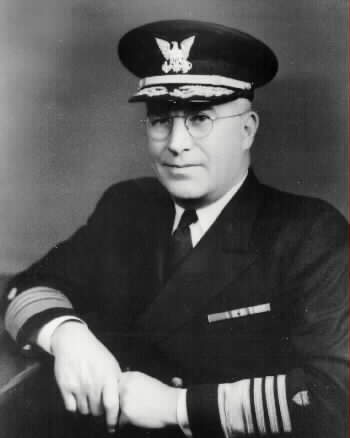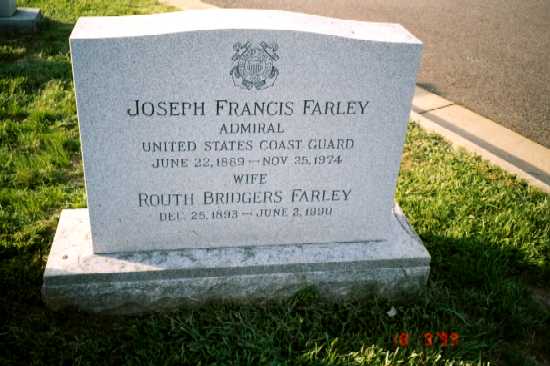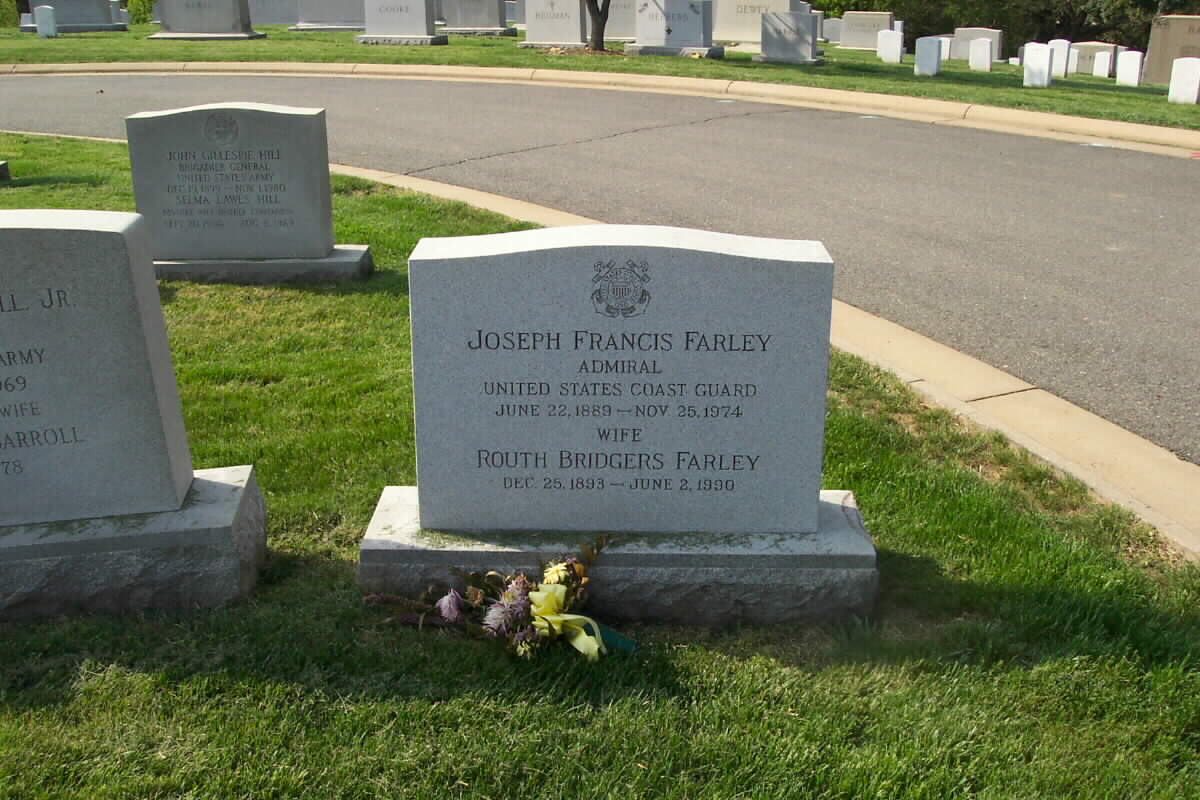Courtesy of the United States Coast Guard
Joseph Francis Farley was born in Oxford, Ohio, on 22 June 1889. The son of Joseph Francis and Sarah Foot Farley, he attended Trumansburg High School, Trumansburg, NY and was graduated from Ithaca High School, Ithaca, NY in 1908. He was appointed a cadet at the Revenue Cutter School of Instruction on 10 May 1909 and he received his commission as a Third Lieutenant in the Revenue Cutter Service on 10 June 1912.
His first assignment was on USCGC Mohawk. He served on board until June 1913. Afterward he was assigned to USCGC Seminole on neutrality patrol in the Caribbean. From July to October 1916, he was on USCGC Onondaga and then was assigned to USCGC Yamacraw from October 1916 to March 1919. When the United States entered World War I, Yamacraw was attached to the Patrol Force of the US Fleet. Later it moved to Gibraltar and served on escort and convoy duty in the Mediterranean and between Gibraltar and the ports of Great Britain. For his service during World War I, he received the Victory Medal with Escort Clasp and the New York State Medal.
After leaving Yamacraw, he was assigned as accounting officer to the New York Division until January 1920. At this time he was attached to the Eagle boat, USCGC Scally. From September 1920 to December 1921, he served on the derelict destroyer USCGC Seneca. His next assignment was on USCGC Gresham from which he was detached in June 1922 to serve on SCGC Morrill. Afterward he joined USCGC Mojave at Honolulu, TH. He served on board this ship until February 1925, when he was assigned to Washington, DC at Coast Guard Headquarters. He served as Ordnance Officer for three years.
He next served with the Destroyer Force that the Coast Guard operated on the Atlantic and Gulf coasts in suppression of smuggling during the “Rum War” era. Initially assigned to command USCGD McCall in March 1928, he was immediately reassigned to command USCGD Wilkes. During his command Wilkes attained the highest score in the Destroyer Force annual target practice during the gunnery year 1928-29. In September 1930 he was assigned the duties of Ordnance Officer for the Destroyer Force. He later assumed the additional duties of Athletic Officer and Service Store Officer for the Destroyer Force. From January 1933 to July 1934, he was commanding officer USCGC Pontchartrain and then was placed in command of USCGC Modoc.
Returning to Coast Guard Headquarters in March 1937, he served as Chief Communications Officer until June 1942. During this time he was technical assistant to the United States delegation to the International Telecommunications Conference at Cairo, Egypt in February-March 1938 and served as the only United States representative at the European Broadcasting Conference at Montreux, Switzerland during March 1939. He also served as a delegate to the International Subcommittee of the Third World Conference of Radiotelegraph Experts for Aeronautics at Cracow, Poland in May 1939. While at Headquarters he was also a member of the Coordinating Committee of the Defense Communications Board and also served as an alternate member of the Board.
In June 1942 he became District Coast Guard Officer of the Eighth Naval District, New Orleans, LA. For his service during this time, he earned the Legion of Merit. Returning to Coast Guard Headquarters in December 1943, he served as Assistant Chief Operations Officer until December 1944 when he was appointed Chief Personnel Officer. He was appointed Commandant, succeeding Admiral Russell R. Waesche on 1 January 1946 with the rank of full Admiral for a term of four years.
After receiving a commission as a Third Lieutenant on 10 June 1912, he was promoted in rank as follows: Second Lieutenant, 31 May 1917; LT, 12 January 1923; LCDR, 1 July 1926, CDR, 27 June 1931; CAPT, 1 December 1941; COMM, 1 June 1943; RADM, 1 November 1943; ADM, 1 January 1946.
Admiral Farley’s tenure as Commandant in the post-World War II era was trying and full of turmoil. Though known throughout the Coast Guard, as the pipe-smoking “Uncle Joe” (a nickname earned as a serious-minded cadet in the Revenue Cutter Service’s School of Instruction), Farley did not attain a great popularity either within the service or without. This was true, in spite of the fact that he always had a good ear for the servicemen’s problems. Farley’s orderly demobilization and reorganization after the war, however, indicated that he was a leader of more than moderate ability. During his tenure the Coast Guard’s responsibility for the duties of the Bureau of Marine Inspection and Navigation, LORAN, the ocean stations were clarified and the personnel problems and statutory definition of its many missions were resolved. Despite having a rough time of it, Farley had demonstrated that Admiral Waesche’s faith in him had been justified.
After a total of 42 years of service in the Coast Guard, Farley stepped down as Commandant on 31 December 1949 and retired effective 1 January 1950. Admiral Farley died on 25 November 1974 after a lengthy battle with throat cancer. He was laid to rest in Arlington National Cemetery. His wife, Routh Bridgers Farley (December 25, 1893-June 2, 1990) is buried with him in Section 4.
Michael Robert Patterson was born in Arlington and is the son of a former officer of the US Army. So it was no wonder that sooner or later his interests drew him to American history and especially to American military history. Many of his articles can be found on renowned portals like the New York Times, Washingtonpost or Wikipedia.
Reviewed by: Michael Howard



